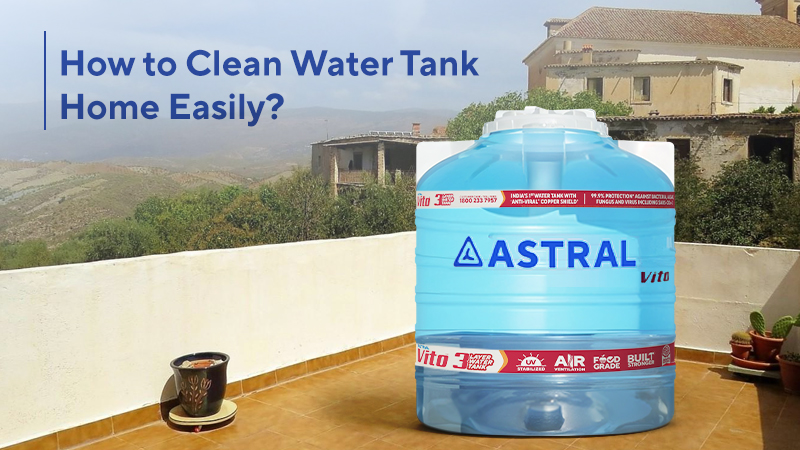
21 Nov 2025
How to Clean Water Tank at Home Easily?
Just like you would not skip a doctor’s appointment, your water tank needs some care and maintenance to keep things flowing smoothly. A clean water tank ensures every drop your family uses is fresh, pure and safe. To maintain better water quality, knowing how to clean water tank at home easily with ease is essential for protecting your family’s health.
The Importance of Cleaning Your Home’s Water Tank
Think of your water tank as a storage container for your most precious resource. Over time, this container can become a breeding ground for unwanted guests, bacteria, algae and harmful microorganisms that you do not want in your drinking water.
When you neglect home water tank cleaning, several problems can arise. Regular cleaning prevents dirt buildup, ensuring crystal-clear water flows through your taps. Beyond health benefits, a clean water tank also helps to extend the life of your plumbing system and household appliances by preventing clogs and corrosion that can cost you thousands in repairs.
Signs That Your Home Water Tank Needs Cleaning
Your water tank often sends clear signals when it needs attention. Here’s what to watch for:
1. Taste and smell changes
If your tap water tastes metallic, sour or has a musty odour, your tank is crying out for cleaning. Fresh water should be tasteless and odourless.
2. Visual indicators
Look for sediment at the bottom of your glasses, floating particles or discoloured water. Brownish or cloudy water typically indicates rust, algae or dirt buildup inside your home water tank.
3. Reduced water pressure
When debris from your tank clogs your pipes, you will notice weaker water flow from taps and showerheads.
4. Algae growth
Those greenish patches on tank walls are health hazards that require immediate attention.
5. Frequent plumbing issues
If you are calling plumbers more often due to clogs or strange noises in pipes, your water storage tank might be the root cause.
Do not ignore these warning signs. Your family’s health depends on taking action promptly.
How to Clean Water Tank at Home Easily Step-by-Step
Cleaning your water tank might seem daunting, but it is simpler than you think. Follow this expert-approved process to clean water tank effectively:
Step 1: Preparation and Safety
Turn off your water supply by shutting the inlet valve and disconnecting any pumps. Always wear rubber gloves and a mask to protect yourself from contaminants and cleaning chemicals.
Step 2: Complete Drainage
Open the outlet valve or use buckets to remove every drop of water. This step is essential because you cannot properly clean a partially filled tank.
Step 3: Physical Cleaning
Using a long-handled brush or mop, scrub every inch of the tank’s interior. For stubborn stains or algae, mix mild detergent with water. The key is reaching all corners and surfaces where contaminants hide. If you are using Astral water tanks, their smooth interior surfaces make cleaning easier and more effective, requiring less scrubbing effort while ensuring thorough cleanliness
Step 4: Thorough Rinsing
Fill the tank partway with clean water, scrub again and then drain completely. Repeat this process until all soap and loose debris disappear.
Step 5: Disinfection
Create a disinfecting solution using household bleach (1 tablespoon per 10 litres of water). Pour it in, scrub the surfaces and let it sit for 1-2 hours. This kills the remaining bacteria and microorganisms.
Step 6: Final Rinse and Refill
Drain the disinfectant completely and rinse multiple times with clean water until there is no chemical smell or residue in the tank. Once odour-free, refill your water storage tank and restore the water supply.
Pro tip: Note your cleaning date to maintain a regular schedule.
How Often Should You Clean a Home Water Tank?
The golden rule for home water tank cleaning is every six months. However, your specific situation might require adjustments to this schedule. Clean more frequently (every 3-4 months) if you live in areas with hard water, frequent water supply interruptions, or high dust levels. Similarly, if you notice any warning signs mentioned earlier, do not wait for your scheduled cleaning.
For households using tank water primarily for non-drinking purposes, you might extend the interval slightly but never exceed 12 months. Remember, prevention is always cheaper than dealing with health issues or plumbing repairs.
Consider seasonal factors too. Before monsoon season, ensure your tank is clean to handle increased water storage. After long dry spells, check for sediment buildup that might require immediate attention.
Choose Water Storage Tanks With Safe Materials
When selecting a water tank, it is essential to choose one made from safe, durable materials. Astral tanks, for example, are built from corrosion-resistant, high-quality materials that ensure water remains clean and safe. Their smooth interiors prevent bacterial buildup, making maintenance easier and ensuring water purity. Explore our range of water tanks for home and residential use.
By opting for tanks made with safe, reliable materials, you can rest assured that your family will have access to safe, fresh water for years to come.
-

21 Nov 2025
How to Clean Water Tank at Home Easily? -

15 Nov 2025
Silent Drainage Pipe VS. Regular Drainage Pipe: Which One Should You Choose? -

08 Nov 2025
Why Underground Cable Ducting is Essential for Modern Infrastructure? -

01 Nov 2025
Why Low-Noise Pipes Are Essential for Corporate Spaces? -

25 Oct 2025
How to Install a Channel Drain?





